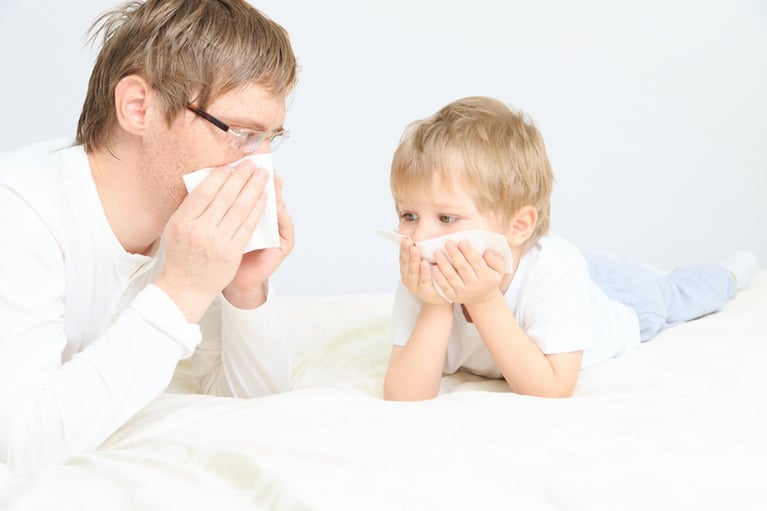The summer season is in full swing and many of us go for shorter or longer trips to the forest or the lake or we walk together with our children through the park. In such moments I think that almost every one of us thinks that things would be really perfect if it wasn’t for the mosquitos and, even worse, ticks! While a mosquito bite is only going to itch for a shorter or longer while, a tick bite is a slightly more serious matter.


However, I’m under the impression that the problem of ticks is demonised and that’s why I would like to provide you – parents – with some useful information on tick bites (although technically, according to medical terminology, ticks don’t bite – their mouthpart is designed for sucking, not biting :))
First of all: let’s not panic. It’s true that some ticks carry Borrelia burgdorferi spirochaetes, but research has shown that the risk of falling ill with the Lyme disease, that is, borreliosis is low if the tick is removed within 24-36 hours. This is the time necessary for the spirochaetes to migrate from the tick’s intestine to its salivary glands. In case of nymphs, that is, ticks in stage prior to achieving their adult form, such migration can take place faster – in 16 hours. However, only a small percentage of nymphs is infected with borreliosis spirochaetes.
The most important thing is to detect the little bloodsucker as soon as possible, so after returning home after a walk in the park or forest it’s worth taking a closer look at our child to make sure they haven’t been bitten. Cursory scanning of the skin may not be enough due to the small size of these arachnids.
Unfortunately, we are attacked most often by their larvae and nymphs, that is, immature forms, which are smaller than adult specimens that reach the size from 2.5 to 4 mm. After a blood meal, the tick reaches the size of even more than 1 cm.

And what if the worst case scenario happens and we are bitten by a tick?Let’s start with what we shouldn’t do.

- Don’t smear any cream or ointment over the tick and don’t submerge it in spirits, because if it’s infected with Borrelia burgdorferi spirochaetes this will lead to stimulation of its salivary glands and increase the risk of borreliosis infection.
- You mustn’t pinch the tick or press the skin around the bite.
- When removing a tick, you mustn’t hold it by its abdomen or press it, because it will result in its mouthpart being torn off and left in the skin.
- You shouldn’t remove a tick with your fingers.
You can remove a tick yourself or, in case when you’re afraid of doing it improperly, you can visit a doctor. If you decide to remove a tick yourself, you have to do it using tweezers (the best ones are the so-called dentist tweezers with a bent ending – you can buy a pair in a pharmacy). I also came across the so-called “tick twister”, that is, a plastic instrument for removing ticks. They are available online, but they won’t work when it comes to removing smaller specimens.
Using tweezers or pincers you grab the tick as close to the skin as possible (this is why it’s important for the tweezers’/pincers’ end to be thin) and pull the tick up in a single continuous move. Don’t make rotary movements and don’t screw the tick out! After removing the tick it’s best to wash the bitten place with water and soap and disinfect it.


If you didn’t manage to remove the whole tick and the hypostome (mouthpart) remains in the skin, this doesn’t increase the risk of borreliosis infection – it may only irritate the skin. Afterwards you can grab the remaining fragment with tweezers/pincers or using a thick sterile needle (you can buy sterile injection needles in pharmacies) and remove it the same way as if you were removing a splinter.
After removing a tick a routine antibiotic therapy is not recommended! However, you should check the bite location for presence of migratory erythema (erythema migrans – EM). It appears usually within 1-3 weeks after the bite, but in extreme situations it can appear even after 3 months!
A typical change of this kind starts as a growing spot that is brighter in the middle.

A doctor will diagnose borreliosis if the change grows up to the diameter of more than 5cm within several days. You can mark the limits of the change with a pen in order to make it easier to notice its enlargement. If the erythema appeared after a period shorter than 2 days after the bite and is smaller than 5 cm, borreliosis can be excluded. However, you should keep checking the bite spot!
In order to diagnose borreliosis – outside of cases when the migratory erythema appears – there are also carried out laboratory tests (determination of the level of IgG and IgM antibodies). After the erythema appears, it is suggested to start antibiotic treatment. Usually it takes at least 21 days. The decision on type and duration of therapy is made by a doctor depending on the clinical picture.

Next to borreliosis, ticks may also carry diseases such as: anaplasmosis, babesiosis, tularemia and tick-borne encephalitis (TBE). Each year in Poland there are recorded about 300 cases of TBE, but this data can be understated due to the fact that some cases have a benign course (with symptoms similar mainly to those of flu) and remain undiagnosed.
Most cases of TBE, as much as 80%, are registered in the north-eastern part of Poland (Podlaskie and Warmińsko-Mazurskie provinces). There are vaccines available against TBE. In order to achieve immunity, three doses are required (second dose after 1-3 months and third dose after 9-12 months) and then application of booster doses every 3 years. The vaccine is recommended to people belonging to risk groups, that is, staying on territories where the incidence of tick-borne encephalitis is high, as well as foresters, farmers, adolescents carrying out vocational practice in the forests or participants of summer and other camps.
To conclude, let me add a few words on testing a tick for presence of Borrelia burgdorferi spirochaetes. Such test is included in the offer of many diagnostic laboratories. It can be carried out, of course, but it doesn’t determine presumptive start of treatment for borreliosis. The decision on diagnosis and commencement of treatment is made by a physician on the basis of the clinical picture, first and foremost.

I hope that the information that I provided will be of use to you. Tick bites shouldn’t be taken lightly, but they aren’t a cause for panic either.















